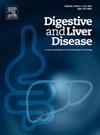Preoperative TIPS and complications and in-hospital mortality in patients with liver cirrhosis undergoing liver transplantation
IF 3.8
3区 医学
Q1 GASTROENTEROLOGY & HEPATOLOGY
引用次数: 0
Abstract
Background
A recent study suggested that preoperative transjugular intrahepatic portosystemic shunt (TIPS) placement in patients with cirrhosis is associated with a lower incidence of complications and in-hospital mortality following non-transplant surgery (JHEP Reports 2024;6:100914). This study aims to evaluate the impact of pre-transplant TIPS placement on postoperative complications and in-hospital mortality in patients with liver cirrhosis undergoing liver transplantation (LT).
Methods
This retrospective cohort study was conducted at the Fondazione Policlinico Universitario Agostino Gemelli IRCCS, Rome, and included all patients who underwent LT between 2015 and 2023. Major exclusion criteria were retransplantation, combined liver-kidney transplantation, and transplantation for indications other than liver cirrhosis. To adjust for baseline differences between patients who received pre-transplant TIPS and those who did not, inverse probability of treatment weighting (IPTW) based on a propensity score model was applied.
Results
The study cohort comprised 263 patients, with a median age of 57.0 ± 13.0 years and a median MELDNa score at LT of 25.0 ± 11.0. Among these, 23 patients (8.7%) underwent pre-transplant TIPS placement—15 for refractory or recurrent ascites and 8 for prevention of variceal bleeding. The median stent diameter was 8 ± 1 mm. Notably, TIPS migration was observed in 30.4% of patients at the time of LT. Patients with TIPS had a higher prevalence of esophageal/gastric varices (p=0.001), previous gastrointestinal bleeding (p < 0.001), ascites (p=0.004), and hepatorenal syndrome (p = 0.04).In the IPTW-weighted pseudo-population, no significant differences were found between patients with and without pre-transplant TIPS regarding total post-transplant hospital stay (p = 0.246), ICU stay (p = 0.994), Comprehensive Complication Index (CCI) scores (p = 0.746), intraoperative mortality (p = 0.167), or in-hospital mortality (p = 0.893). However, the rate of reoperation was significantly higher in the TIPS group (17.4% vs. 8.0%, p = 0.003). In a parsimonious logistic regression model weighted by IPTW, preoperative TIPS presence was not associated with in-hospital mortality (p = 0.902).
Conclusions
Preoperative TIPS placement may enable patients with severe portal hypertension to achieve postoperative outcomes comparable to those without TIPS in terms of complications and in-hospital mortality. Nevertheless, preoperative TIPS does not appear to provide a survival advantage in patients on the transplant waiting list and should therefore be reserved for indications established by current guidelines.
肝硬化肝移植患者术前TIPS与并发症及住院死亡率的关系
最近的一项研究表明,肝硬化患者术前放置经颈静脉肝内门系统分流术(TIPS)与非移植手术后并发症发生率和住院死亡率较低相关(JHEP报告2024;6:100 - 914)。本研究旨在评估移植前置放TIPS对肝硬化肝移植患者术后并发症和住院死亡率的影响。方法本回顾性队列研究在罗马Agostino Gemelli IRCCS进行,纳入了2015年至2023年间接受过肝移植的所有患者。主要的排除标准是再移植、肝肾联合移植和肝硬化以外适应症的移植。为了调整移植前接受TIPS和未接受TIPS的患者之间的基线差异,应用基于倾向评分模型的治疗加权逆概率(IPTW)。结果研究队列包括263例患者,中位年龄为57.0±13.0岁,LT时MELDNa中位评分为25.0±11.0。其中,23例患者(8.7%)接受了移植前TIPS放置,其中15例用于难治性或复发性腹水,8例用于预防静脉曲张出血。支架中位直径为8±1mm。值得注意的是,在lt时,30.4%的患者观察到TIPS迁移。TIPS患者有更高的食管/胃静脉曲张(p=0.001),既往胃肠道出血(p < 0.001),腹水(p=0.004)和肝肾综合征(p = 0.04)的患病率。在IPTW-weighted pseudo-population,之间没有显著差异被发现,没有患者移植前提示关于移植后总住院时间(p = 0.246),ICU停留(p = 0.994),综合指数(CCI)并发症(p = 0.746),术中死亡率(p = 0.167),或住院死亡率(p = 0.893)。然而,TIPS组的再手术率明显高于对照组(17.4% vs. 8.0%, p = 0.003)。在IPTW加权的简约逻辑回归模型中,术前TIPS的存在与住院死亡率无关(p = 0.902)。结论术前置放TIPS可使重度门静脉高压症患者在并发症和住院死亡率方面达到与未置放TIPS患者相当的术后效果。然而,术前TIPS似乎不能为移植等待名单上的患者提供生存优势,因此应保留用于当前指南确定的适应症。
本文章由计算机程序翻译,如有差异,请以英文原文为准。
求助全文
约1分钟内获得全文
求助全文
来源期刊

Digestive and Liver Disease
医学-胃肠肝病学
CiteScore
6.10
自引率
2.20%
发文量
632
审稿时长
19 days
期刊介绍:
Digestive and Liver Disease is an international journal of Gastroenterology and Hepatology. It is the official journal of Italian Association for the Study of the Liver (AISF); Italian Association for the Study of the Pancreas (AISP); Italian Association for Digestive Endoscopy (SIED); Italian Association for Hospital Gastroenterologists and Digestive Endoscopists (AIGO); Italian Society of Gastroenterology (SIGE); Italian Society of Pediatric Gastroenterology and Hepatology (SIGENP) and Italian Group for the Study of Inflammatory Bowel Disease (IG-IBD).
Digestive and Liver Disease publishes papers on basic and clinical research in the field of gastroenterology and hepatology.
Contributions consist of:
Original Papers
Correspondence to the Editor
Editorials, Reviews and Special Articles
Progress Reports
Image of the Month
Congress Proceedings
Symposia and Mini-symposia.
 求助内容:
求助内容: 应助结果提醒方式:
应助结果提醒方式:


